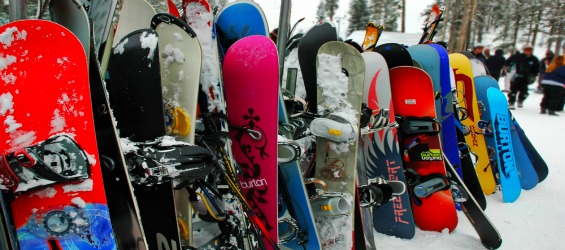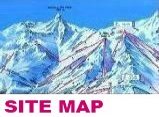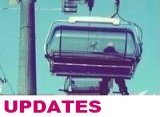
Types of snowboards: a simple guide
Information on different types of snowboards is all over the web. However, the information is either too basic and of no use or it is so complex that even Stephen Hawking would struggle to understand it.
This article will be somewhere in the middle. By the time you have finished reading you will understand the 3 main areas that can differ when a snowboard is made. You will know about...
-
How materials used affect the different types of snowboards performance
-
Snowboard shapes
-
Snowboard profiles
Only after you have this knowledge on the types of snowboards can you go and find out how to buy a snowboard that is perfect for you based on your experience and riding style.
![]()
Snowboard materials
Like with anything that you build, the materials used make a difference to how it will perform. The two main areas that are affected on a snowboard are 1: flexibility and 2: weight.
Snowboard flex
Simple really. The more flexible or softer the snowboard is, the easier it is to pop, turn and do jib tricks on. These softer boards are usually preferred by those who love the park and freestyle riding. Stiffer boards are more stable at speed and are favoured by those who love to go big and fast or hit bigger jumps.

Note:
When you buy a new board it will have some kind of rating on it regarding it's flex. Keep this in mind and make sure you get a board suitable for the riding you do the most.
Snowboard weight
This one is pretty easy too. The lighter the board then the faster it will be in the turn. Either in the air or on the deck. Remember this though...with different types of snowboards, as the weight goes down, the price tends to go up. You will pay top prices for the lightest boards on the market.
![]()
Snowboard shape
A snowboards shape will affect how quick it is through the turn and how it performs in the different types of conditions you find on the mountain. The 2 factors that are changed on to alter the shape on the different types of snowboards are 1: Length and 2: Sidecut.
Snowboard length
The length of a board will make a huge difference to how it performs in different conditions. The range of lengths on the various types of snowboards goes from about 120cm up to 165cm. Shorter boards tend to be better for beginners as they are easier to control and manouver. More advanced riders may prefer a slightly longer board that will be more stable at speed and in deeper snow.
Snowboard sidecut
The sidecut of a snowboard is just another word for the piece that has been taken out of the side of the board when it is being looked at from the top.

A larger radius cut will mean the board turns more smoothly in flowing turns, a smaller radial cut will mean the cut is tighter and the board responds quicker and makes tighter turns.
More complex sidecuts are appearing on boards now as technology develops. Boards such as the lib-tech skate banana have a ripple affect down the side of the board, designed to increase the grip through the turn due to more contact points that touch the snow.
You could go even more technical but there isn't really any need to. As a beginner/intermediate rider you don't need to worry too much about this stuff. Just be aware that there are different sidecuts out there. If in doubt and want to know more then pop into your local boarding shop and pick the brains of the shop assistant for a few minutes.
The 3 main snowboard shapes
Depending on how far forward or back the sidecut is set will determine the overall shape of the board, with different types of snowboards this will affect how well it performs in different snow conditions and how easy it is to ride backwards (switch). The 3 main shapes are:
Directional snowboards

These boards are slightly wider at the nose than they are at the tail. This makes it easier to turn the board and carve down the mountain. This shape is normally found on all-mountain snowboards. This shape holds up well at speed and can be ridden mostly anywhere on the mountain.
True twin snowboards

These are pretty much symmetrical. The nose and tail of the board are the same shape and the binding mountings are set directly between them both. These boards are usually slightly softer with more flex. They are great for jibbing around the mountain and can be ridden switch as easily as they can forwards. Freestyle boards are usually a true twin shape.
Directional twin boards

These boards have a nose and tail that is pretty much the same in shape. The tail will be a bit less flexible than the nose. A stiffer tail will give the board more pop. These boards are great for all-mountain and park riding.
Wide boards
Most boards come with a wider waist version for those of you who have larger feet and need bigger boots and bindings. If this is you then a new board will be marked as a wide board so keep your eyes peeled.
Shape exceptions
Some snowboards have weird and wonderful shapes and have been designed for very specific snow conditions. Specialist powder boards may have a swallow shaped tail which will aid turns in very deep powdery snow. The nose is usually more of an angle aswell to stop it digging in when riding in these conditions.
![]()
Snowboard profiles
It wasn't until I bought my new kit that I started to take any real notice of the the different types of snowboards and their profiles. I was surprised at what I found. When I bought my first board you could lay most snowboards down on a flat surface and from the side they would all look pretty much look the same...this is no longer the case.
Since the introduction of the Skate banana snowboard by Lib-tech, snowboard profile research and technology has become big business. Companies are experimenting with board profiles because they can make such a huge difference to how a board performs and rides. Exciting times!
To give you an idea of what profiles are around and how they will effect your ride, here is an introduction to the 4 main types.
Conventional camber snowboards
What does it look like?
A rocker board touches the ground in the middle of the board between the bindings and then peels away from the snow towards the nose and the tail.
How will it ride?
The entire edge of these boards is always in contact with the snow. A flat base board will not have as much pop or power out of a turn as a conventional board and are more suited to riding styles that do not require this such as slaying the half pipe.
Rocker/camber combination boards
What does it look like?
These boards are any combination of the conventional camber and rocker snowboards. Depending on who makes the board it could touch the snow at any number of contact points.
How will it ride?
It will perform somewhere in between how a conventional camber and rocker board would do. The manufacturers are trying to mix the different types of snowboards in an attempt to get the best of both worlds. I personally think that the benefits of each get watered down. However, some people love them and you might too. The only way you can really know would be to try one for yourself.
![]()
We hope this guide to the different types of snowboards has given you some knowledge about the boards that are available to you at the moment. If you have any questions about the types of snowboards and want to know more then please drop us an email through the Contact us page.
Back to "Snowboarding home" from "Types of snowboards"
Back to "Snowboard equipment" from "Types of snowboards"




New! Comment using Facebook
Want to say something about this page? Leave a comment in the box below.